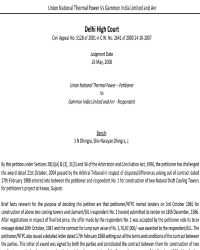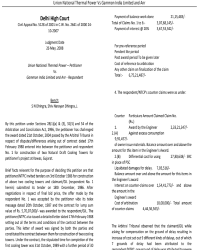E.P. Poulose
v.
State of Kerala & Another
(Supreme Court Of India)
Civil Appeal No. 1435 Of 1974 | 21-04-1975
Goswami, J.
1. This is an appeal by special leave against the judgment of the Kerala High Court Setting aside the judgment of the Subordinate Judge, Ernakulam and restoring the award of the Arbitrator who had earlier refused the claim of the appellant.
2. The appellant (briefly the contractor) was a successful tenderer for construction of three zonal R.C.C. Overhead Reservoirs, two in Mattancherry and one in Cochin, in connection with the Ernakulam Mattancherry Water Supply Scheme. In the schedule annexed to the notification inviting tenders under the heading 'Site' it was stated that " the soil at the site for Reservoir No.1 and Reservoir No. 2 is loose clay and for Reservoir No. 3, sandy". 'The tenders was to execute an agreement on a stamped paper before commencing work. It appears later on the Kerala Engineering Research Institute, Peechi, Soil Mechanics and Foundation Division (briefly the Research Institute) submitted a report (Ext. P. 19 dated September 14, 1965) that the sub-soil at the three places chosen as sites for the reservoirs up to 16 m. showed that the top soil was sand, the middle layer clay, and the bottom layer, silty sand or sand. It was stated that the clay found at the three places was of a highly compressible nature and hence pile foundation was preferable and that as the top strata was sandy jetting had to be resorted to for driving the piles through this strata. After receipt of the opinion of the Research Institute, respondent No. 2 ( herein after to be described as the Department ) gave instructions to the contractor to adopt the process of jetting for driving piles for the tank at Thoppumpady which is alone in dispute in this case. On October 7, 1965, the Chief Engineer after scrutinising the pile design of the contractor wrote to him, inter alia, as follows:
"The piles as per design submitted with raft like cap may be adopted for tank at Thoppumpady where the length of pile suggested by the research division is in the region of 30 ft...Jetting has to be resorted to in the top strata where sandy layer is met with..... Your statement that piles of more than 30 ft. length is very difficult to be driven in Ernakulam is not quite convincing to the Department.
Any how a decision will be taken on this only after ascertaining the details regarding the practical difficulties if any from agencies actually engaged in such type of works in the locality.
Meanwhile you may please execute the agreement and start the work on the Reservoir at Thoppumpady receiving further instructions from Executive Engineer, Public Health, Alwaye". (Ext. P. 1).
On February 21, 1966 the contractor wrote to the Executive Engineer informing him that as per instructions of the Research Institute and site conditions he provided jetting arrangements for driving the piles although the process of jetting was not included in his tender. He enclosed the details of expenditure on that account and mentioned that for the pile casting he used extra reinforcement for additionally strengthening the head of piles due to the site condition. He pointed out that this was not included in his original design. The sum and substance of the contractor's grievance was that he assumed the site condition to be as represented in the schedule to the notification inviting tenders and submitted his original design on that basis and since, however, the site condition was found to be different and on the advice of the Research Institute jetting had to be resorted to involving extra expenditure he was entitled to claim to additional amount for the work of jetting. The Department, however, refused the claim which led, to the arbitration under clause 34 of the tender notification. The Arbitrator was the Chief Engineer. It appears the award was based on examination of documents and after hearing arguments of the parties.
3. The award with which we are concerned is a speaking one and gives the reasons for the decision against the contractor. Mr. Gupte, the learned counsel for the appellant submits that the Arbitrator was guilty of legal misconduct in conducting the proceedings. He submitted that two very material documents, Exts P. 11 and P. 16, were absolutely ignored by the Arbitrator resulting in miscarriage of justice. On the other hand Mr. Krishnamurthi Iyer submitted that these documents were not even marked before the Arbitrator; they were marked only before the Subordinate Judge. According to him, therefore, there is no foundation for the grievance.
4. We have been taken through all the relevant documents by the learned counsel for both sides and we are satisfied that Ext. P. 11 and Ext. P.16 are material, document to arrive at a just and fair decision to resolve the controversy between the Department and the contractor. In the background of the controversy in this case even if the Department did not produce these documents before the Arbitrator it was incumbent upon him to get hold of all the relevant documents including Exts. P. 11 and P. 16 for the purpose of a just decision. Ext. P.11 dated September 8, 1966, is a communication from the Superintending Engineer to the Chief Engineer with regard to the objections raised by Audit in connection with the construction of the reservoirs. The following extract will explain the position then taken by the Department:
"The contention of the Accountant General that jetting was resorted to by the contractor to facilitate the driving of the piles is not correct. Had it not been for jetting, it would not have been possible for the piles to reach the required depth of 30', passing through sandy strata and we would have been constrained to stop with a smaller depth viz., up to the point of refusal for penetration of the pile by hammering. It was, therefore, in the interest of the work that jetting was insisted upon by the Department for pile driving. The contractor had to resort to jetting under instructions from the Department.
The Accountant General has stated that the department is not bound to pay extra for adopting the method of jetting for pile driving. This does not appear correct since the method of jetting was adopted in the interest of the department in view of the sandy stratum obtaining at the site as against the indication given by the department that the soil is clayey up to a depth of nearly 200 ft. No doubt the contractor was asked to ascertain the nature of the soil; but this does not imply that he was to conduct exploratory borings to confirm the classification given by the department in the tender within the short span of time available for submitting tenders".
Earlier also on July 25, 1966, as per Ext. P, 16 the Executive Engineer had written to the Chief Engineer where from paragraph 4 is revealing:
"Even though while inviting tenders for the work there was a condition that the tenderer should examine the soil condition it was not expected of them to do soil testing in detail within the period available to them to tender for the work. A clear indication regarding the nature of the strata that is likely to be met with was also furnished at the time of inviting tenders. After complete soil investigation the strata was found to be different from that furnished by the department and so in my opinion technical specification has changed. In the circumstances jetting done by the contractor can be considered as an extra item".
5. We now come to the award. Although the Arbitrator has held that "jetting, however, is not an authorised extra covered by the agreement", he has made the following significant' observation which is inconsistent with his conclusion that the contractor has no right for extra payment for the jetting:
"The Chief Engineer has rejected the claims of the contractor on grounds of non-inclusion of this (jetting) in the agreement which was executed subsequent to the direction issued by the department to adopt jetting. The Chief Engineer's decision totally ignores the next sentence in that letter 'Meanwhile you may execute the agreement.' By this sentence the issue of extra payment for jetting is left open even after the execution of the agreement."
If the above is the conclusion of the Arbitrator, rejection of the claim on the ground that "jetting, however, is not an authorised extra covered by the agreement" cannot be anything but rationally inconsistent. The award, therefore, suffers from a manifest error apparent ex facie.
6. Under Section 30 (a) of the Arbitration Act an award can be set aside when an Arbitrator has misconduct himself or the proceedings. Misconducted under Section 30 (a) has not a connotation of moral lapse. It comprises legal misconduct which is completed if the Arbitrator on the face of the award arrives at an inconsistent conclusion even on his own finding or arrives at a decision by ignoring very material document which throw abundant light on the controversy to help a just and fair decision. It is in this sense that the Arbitrator has misconducted the proceedings in this case. We have, therefore, no hesitation in setting aside such an award. In the result the judgment of the High Court is set aside and that of the Subordinate Judge is restored. The award of the Arbitrator thus stands quashed. The Arbitrator will complete the proceedings after considering all the relevant documents including Ext. P. 11 and Ext. P. 16 after giving opportunity to the parties. The appeal is allowed with costs.
7. Appeal allowed.
Advocates List
For the Appellant S.V. Gupte, Sr. Advocate, M/s. C.J. Balakrishnan, A.S. Nambiar Advocates. For the Respondents T.S.
Krishnamurthy Iyer, Sr. Advocate, K.R. Nambiar. Advocate.
For Petitioner
- Shekhar Naphade
- Mahesh Agrawal
- Tarun Dua
For Respondent
- S. Vani
- B. Sunita Rao
- Sushil Kumar Pathak
 Issue
Issue Facts
Facts Arguments Of Petitioner
Arguments Of Petitioner Reasoning
Reasoning Decision
Decision


